#nahel merzouk
Explore tagged Tumblr posts
Text
The way the killing of the French teen is being reported on TV and websites...it is never apparent what his race, ethnicity or religion is.....are they doing that on purpose? I had to open and read several articles to get the full picture.
I know for a fact that this is not how they do their reports when someone with a different profile is the victim, or something that liberals are obsessed with happens.
And the way these reports are written/televised doesn't in any way paint France, their police or their society's attitude towards certain people as a negative thing. I'm especially baffled by how non-chalant everyone sounds about the police person who did that and the police in general.
It's stupid and maddening how differently these so-called modern, champions of human rights, woke, liberal and whatever else the heck these countries call themselves treat certain situations so differently.
Edit: I guess my main question that I wasn't able to make clear in this angry rant is: Is everyone pretending that the killing wasn't motivated at least in part by the profile of the victim? Would the police have done the same with someone who was 'similar' to them? How would the media reports and global outrage look like if the profiles of the victim and killer were switched?
#i really had to find several articles to get the full picture of who the victim was and what had happened#i really want to take names of certain groups/communities who demand such special treatment for themselves when nothing even happens#france is worse than the US in some respects#nahel merzouk
2 notes
·
View notes
Text
This Week in Prophecy: Lawlessness; Magog's Mess; Taiwan
This Week in Prophecy: Lawlessness; Magog's Mess; Taiwan
Matthew 24:12 Because lawlessness is increased, most people’s love will grow cold. France: Day 5 of the riots and counting. France is on fire. 719 and counting have been arrested across France. This has been the response to the death of Nahel Merzouk, a 17 year old of Algerian descent. He was shot by the police during a traffic stop. The incident occurred in the Parisian suburb of Nanterre.…
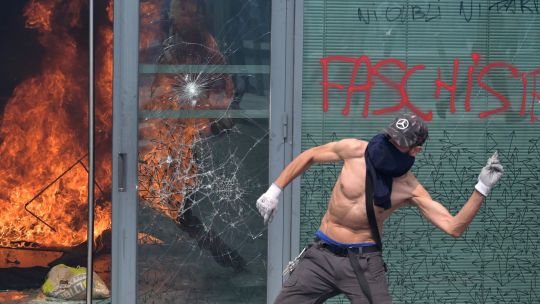
View On WordPress
#Alexander Lukashenko#Belarus#china#France#Nahel Merzouk#Nuclear Weapons#One China Policy#Paris#Prigozhin#riots#Russia#Secretary of State Antony Blinken#Taiwan#Wagner Group
0 notes
Text
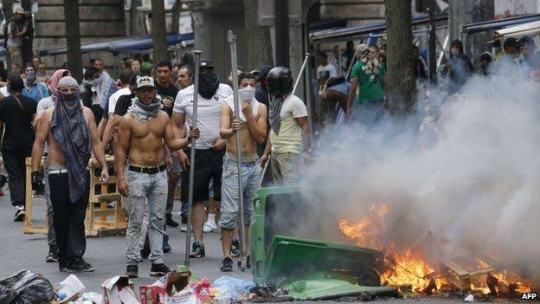


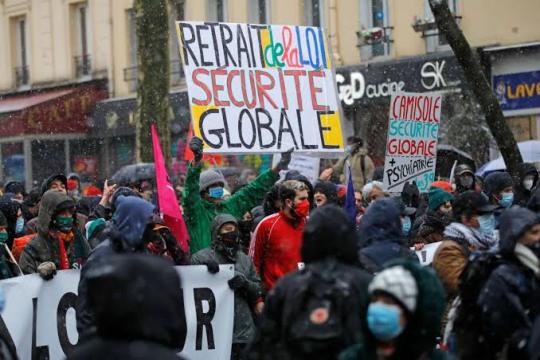
6 notes
·
View notes
Text
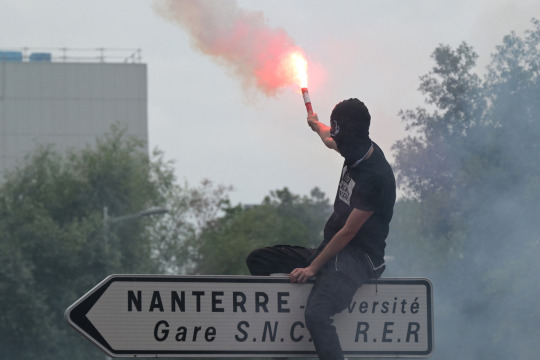
France: Learning from the Flames
https://crimethinc.com/Nahel2023
On June 2023, in the city of Nanterre, a suburb of Paris, police brutally murdered a teenager named Nahel Merzouk, continuing a pattern of post-colonial violence directed at a sector of the French population that is treated as second-class citizens.
In response, thousands of people in the outlying banlieues of Paris and other French cities engaged in several days of pitched revolt, attacking town halls and police stations, looting shops, and defending themselves against the police.
In this reflection, a participant looks back on the revolt of June 2023 and the movements that preceded it, exploring the limits they reached and considering what it would take for such movements to bring about revolutionary transformation.
335 notes
·
View notes
Text
Some times ago, I posted about the vandalizing of the Wall of the Justs at the Parisian Shoah memorial. The post is here if you are interested, and it got many, many notes, so I thank you very much!
But I hope this post will also get as many notes - because we found the guilty party. We know who did it and... gosh, it sounds like a fucking joke but it is not, and it just proves how complex the situation is, and how dangerous the times we are living are.
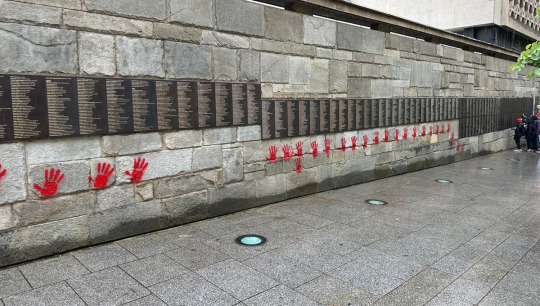
If you recalled the obvious guilty party, the first suspects, the ones that seemed to have done that were the so-called "pro-Palestinian" activists that in fact are just antisemitic people disguising their hatred under the pretense of "fighting for Palestine". It is well-known that the pro-Palestinan manifestations, events and representatives in France have all versed at one point or another into very antisemitic comments or actions, and the movement is currently being parasited by antisemitism - ranging from actual antisemites who use "Zionist" as a way to designate all Jews, including French-Jews who never saw Israel in their life ; to people who are taking back antisemitic slogans without knowing they are antisemitic in the first place.
The reason the investigation directly was aimed at them was very simple: the red hands, or red handprints, is a symbol that many pro-Palestine manifestants have been using recently. Which, in itself, sparked a whole new debate - about whether it is an antisemitic symbol or not. Because while for some it is the universal "You have blood on your hands" symbol, for others it refers to the blood of a soldier of Israel on the hands of his murderer, during the second Infifada... And while attacking the Wall of the Justs would have been a new low and a new step for these left-leaning antisemites (because so far they only attacked Jews, now they would attack those that saved Jews and assorted Nazi victims during World War II), it was in line with a new form of radicalization of the movement - see the "Block Out" phenomenon on Internet, a cancel culture aimed at those that did not support enough Palestine... As a personal note I will say: where was all this energy and effort when the it was time to defend the Uyghurs against their wiping out by the Chinese regime? It is still time today, their suffering is still going on... But as a prominent Uyghur activist said (I think it was Rebiya Kadeer, but I do not have my notes with me so I might be mistaken) - people care less about the Uyghurs than Palestinians for one simple reason "Because it isn't Israel that is killing us..." It is China, and as a result nobody really cares...
Anyway, I digress... So while it is known, confirmed and recorded that the so-called "pro-Palestine" activists in France are slowly oscillating and sinking into antisemitism, it isn't actually them who did these red handprints. No, they're not guilty this time.

In fact it is something I talked about when I made my original post: there was another very likely suspect which would have surprised nobody. Neo-Nazis. Because while the pro-Palestinian movement is currently crystallizing in France the entire antisemitism wave that has been on the rise for a decade now among the extreme-left, the extreme-right political groups have also been gaining terran and strength for quite a long time, and now, we have actual neo-Nazi parties very vocal and active today... Due to the ungodly amount of terrorist attacks France had to face, due to the frightening strenghtening of radical and extreme Islam in France, due to the whole endless debates about immigration in France, and due to the hyper-violent civil unrests that are clearly just to cause chaos and nothing else (like the riots following the death of Nahel Merzouk, which clearly were not about the Nahel case and just to cause as much destruction and steal as much things as possible)... Well of course, when these types of problem arise, who gains the upper-hand? The extreme-right.
And so now we have far-right candidates so popular they have a good chance of being elected as the representatives of France, and we have many groups of antisemitic Christian fanatics popping up everywhere, and we have neo-Nazi movements literaly returning like some perverted phoenix from their ashes... As such, it was thought that maybe these red handprints could have been the work of a neo-Nazi movement, who would use the current situation to perform their antisemitic deeds while blaming the extreme-left for it... After all, the two movements have been currently doing the exact same thing. Before the Hamas attack, far-right groups were defacing Jewish cemeteries and soiling Simone Veil's grave with Nazi swastika ; and today far-left activists are "denouncing" Israel by... tagging on Jewish temples drawings mixing the six-point stars with a swastika...
So, you know, the typical horseshoe effect. The two extremes are literaly doing the same things, and as such we have a hard time differentiatng one from another.
But no... Turns out it isn't them either! Turns out... it isn't even French people who did this.
And here's where the dark joke comes... You know who did it? FUCKING RUSSIA OF COURSE!
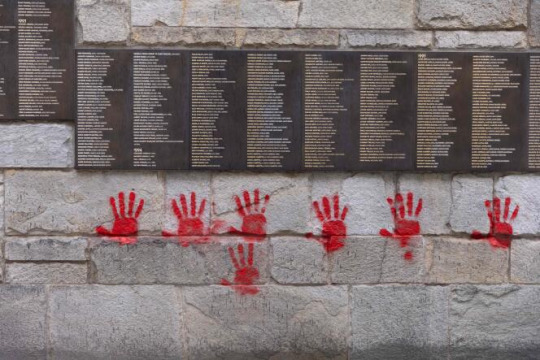
We forget to so easily that Putin is literaly sending his agents in every friggin' political or social event that goes on in the world right now... And in fact that's the whole point: Putin wants us to be so obsessed with the Israel-Hamas conflict and how Gaza is trapped in it all, so that we forget about how Russia is currently destroying Ukraine.
The investigation found out that the people who painted these red hands were three men that had recently arrived in Paris from Bulgaria... They were staying at an hotel and the very day following their crime, they left France for Belgium (Bruxelles to be precise). Now... You're going to say "So they're just Bulgarians? They're not Russians, nothing proves its Russia". Except for one thing... While yes the involvment of Russia has not been "confirmed", Putin's Russia is not known for its vivid imagination... And they have literaly done the same thing some times ago.
If you recall, I posted about it before... It happened last october. Right after the Hamas attacked the music festival, causing the whole madness we are into today, blue David stars were painted on buildings where Jewish people lived, echoing the dark times of the Nazi Occupation in France... Here is the post I made back in February, and I couldn't guess how far things would go back then... While everybody was getting scared about the return of French antisemitism turned out... It was a group of people from Moldavia that was paid to paint those stars everywhere. Paid by... a pro-Russian, pro-Putin Moldavian businessman, Anatoli Prizenko.
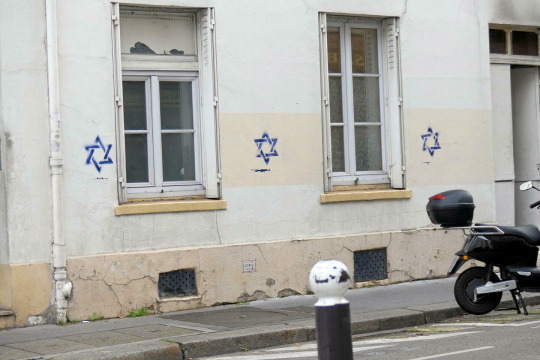
You can read more about this on my old post, but investigation concluded it was indeed an operation where Russian forces used the Moldavians as puppets. All to cause fright and chaos in France. When you consider that Bulgaria, like Moldavia, is unfortunately today one of the "screen-countries" Russia likes to use to shield themselves when doing their dirty chores... Blue stars, red handprints... This is clearly the same thing, done all over again.
And where the "joke" part comes out even more - in the sense of a perverse, venomous, fetid joke part of some putrid dark comedy... Russia has currently been truly harassing France through all sorts of operations, each more outlandish than the next, and yet all working in their own way to cause fear and chaos... More specifically two cases are regularly being brought up.
Case 1: The Doppelgänger operation
In June of 2023, the French authorities warned about what was called the "Doppelgänger operation". A massive campaign of Internet misinformation created by Russia. The purpose was simple: create mirror-websites to the official websites of French information networks, newspapers and TV channels. They were almost identical to the official news outlet of France, to the point many mistook them for the real thing - sometimes the only difference you could spot was in the URL. ".fr" became ".ltd", and ".com" became ".cam".
And all those fake websites shared articles about the Ukrainian-Russian war, articles written purposefully to spread misinformation about Russia. Some claimed that the Ukrainian population were in full distrust of their government and wanted to see it brought down... Others wrote that all the Ukrainian operations were disasters and failures. Some invented fake tragedies and disasters in Russia to try to paint Ukrainians as the villains. And others yet wrote about how the donations of Europe to Ukraine were either wasted by the Ukrainians, or would cause economic crisis in European countries...
Case 2: The bed bugs hysteria
In september of 2023, the discovery of bed bugs on several public places in Paris was shared on social media. Some were discovered in a movie theater, the presence of others was attested in some subway lines... The social media being what they are, it became a hot topic talked about by everybody, shared by everyone - and the facts were exaggerated, and rumors started spreading, and soon an entire mass hysteria started overtaking France. It wasn't just Paris anymore, but all the big cities that were supposedly infested by "bed bugs". People claimed to find them in every public places - every theater, every subway line, every hotel, even in hospitals...
Turns out, there wasn't as much bed bugs as the social media wanted us to believe. It was mostly a sanitary mass panic, echoing the fear caused by the Covid epidemic and fed by the worries about the upcoming Olympic games. And... and also fed by Russia. Investigations revealed that there was a lot of fake accounts, troll accounts and bots created by Russian servers and Russian URLs, and who spent their entire time spreading and sharing bed-bugs articles, writing fake articles twisting the facts, and spamming everybody with news of this mass hysteria..
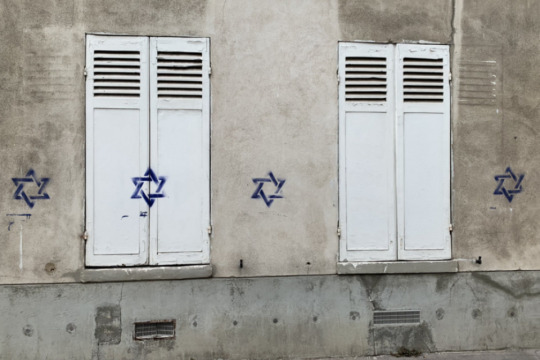
This is the sore and infuriating conclusion. Remember, everyone, that this isn't just about Israel and Palestine... It isn't just about the Hamas or Netanyahu... And we already knew that, because already in Europe it was clear this wasn't truly about what happened in the Middle-East - it was also about the shadows of antisemitism and the wraith of the Nazi presence, it was about the extreme-left movement spreading from the USA university down to European ones, it became a fight about the Jewish and Muslim populations in Europe rather than in Palestine and Israel - and even more, a political fight between the far-right and the far-left across the continent... But it isn't just about that anymore, because now Putin is in the dance and Russia is gleefully putting oil on the fire in hope it will burn everything... This is a fucked-up chess game with many, many players... That all look the same in the end, somehow, so it becomes hard to identify which one does which move.
But at least we know who painted the blue stars, and who painted the red hands, and who pits the extreme-left against the extreme-right, and is trying to make sure the Jewish people of France are feeling scared in their own country. Putin and what he turned Russia into.
#france#putin#russia#antisemitism#shoah memorial#wall of the justs#putin's russia#russian propaganda#far right#far left#extreme right#extreme left#misinformation#mass hysteria#antisemitic#ukraine
70 notes
·
View notes
Text
System Fail 25: The Urge to Destroy
youtube
As humanity recons with a never ending cavalcade of catastrophes, large segments of the population have succumbed to despair or distraction through culture wars or a series of vain cultural phenomena. [Insert Barbenheimer joke here.]
Many youth, particularly in France, have channeled this hopelessness into rage. For the past several months the country had been seeing a series of strikes and riots in response to the raising of the retirement age, and these riots intensified in late June after the police murder of 17-year-old Nahel Merzouk during a traffic stop. As the dust settles, inept politicians blame bad parenting and TikTok.
Meanwhile in Peru, protesters from around the country have gathered in Lima calling for the resignation of President Dina Boluarte and the dissolution of congress.
#submedia#systemfail#25#The Urge to Destroy#paris riots#161#1312#barbenheimer#mitch mcconnell#peru#france riots#france protests#france#nahel#marseille#nanterre#macron#franceonfire#stroke#mitchglitch#francocide#dina boluarte#PeruEnDictadora#lima#peruprotests#ausgov#politas#auspol#tasgov#taspol
21 notes
·
View notes
Text

RAID during the "Nahel Merzouk Riots" in 2023
2 notes
·
View notes
Text
At 19, he was the oldest of the group of teens accused of hurling Molotov cocktails at the police station of their suburban hometown.
“Why?” the judge asked Riad, who was taken into custody after he was identified in video surveillance images of the group from June 29, the second night of nationwide unrest following the police shooting of another suburban teenager outside Paris.
“For justice for Nahel," Riad said. Slumped and slightly disheveled after five nights in jail, he said he didn't know about the peaceful march organized by Nahel Merzouk's family. He explained that the cellphone photo of him holding a Molotov cocktail was “for social media. To give an image.”
In all, more than 3,600 people, with an average age of 17, have been detained in the unrest across France since the June 27 death of Nahel, who was also 17, according to the Interior Ministry. The violence, which left more than 800 law enforcement officers injured, has largely subsided in recent days.
French courts are working overtime to process the arrests, including opening their doors through the weekend, with fast-track hearings around an hour long and same-day sentencing.
The prosecutor noted that Riad had learned where to acquire incendiary devices on Snapchat, the social network that the French government has singled out, along with TikTok, as fueling the unrest. Riad's lawyer noted that his record was clean and that the young man was not blamed for any significant damage or injuries.
By the end of Tuesday, Riad's sentence was fixed: three years in prison, with a minimum of 18 months behind bars, and a ban from his hometown of Alfortville for the duration of the term.
He collapsed on the stand. “I'm not ready to go to prison. I'm really not ready,” he said, blowing a furtive kiss to his mother as he was led away.
Outside the packed courtroom, a pair of girls asked someone exiting what sentence he'd received. “Three years? That's insane!” one exclaimed.
But the mood in France is stern after unrest that officials estimate caused more than $1 billion in damage. Nahel's fatal shooting by police came during a traffic stop, was captured on video and immediately stirred up long-simmering tensions between police and young people — nearly all ethnic minorities and overwhelmingly French-born — in housing projects and disadvantaged suburbs.
Justice Minister Eric Dupond-Moretti issued an order Friday that demanded a “ strong, firm and systematic” judicial response. Hearings began the following day, as unrest continued into the night.
“This is not hasty justice. The message I want to send is that justice is functioning normally in the face of an exceptional situation," said Peimane Ghaleh-Marzban, the president of the tribunal in Bobigny.
By Tuesday night, a total of 990 people had gone before a tribunal, and about one-third received jail terms, according to government spokesman Olivier Veran. A third of those detained were minors, he said.
“You have many first-time offenders — people who are not deep in delinquency, many minors in school who don’t [engage in] habitual criminal activity,” Ghaleh-Marzban said.
Despite that, the inclination to convict with jail time appeared to prevail.
In Lyon, France's second-most populous metropolitan area, the prosecutor said Thursday that of 26 adults who have appeared before the fast-track courts so far, 22 were convicted and sentenced to jail, three requested more time to prepare a defense and only one was acquitted. According to BFM television Thursday, 76% of people in the fast-track trials were placed in detention.
The United Nations' human rights office said the unrest showed that it was time for France to reckon with its history of racism in policing, rather than just lash out in punishment. The office said the French government needed to ensure that use of force “always respects the principles of legality, necessity, proportionality, non-discrimination, precaution and accountability.”
But many French lawmakers are demanding maximum punishment — and fast.
Olivier Marleix, a lawmaker from the conservative Republicans party, called for all the cases involving the unrest to be handled within 100 days.
“Not to punish this would be an injury to all our law enforcement. Not to punish this would be a failure to understand the gravity of the threat to France," he said Tuesday in the National Assembly.
By contrast, the officer accused in Nahel's death has been charged with voluntary homicide but has yet to appear in a courtroom or even have a court date set.
Rayan, an 18-year-old detained with a group of about 30 young people, was accused of filming a 14-second video of incendiaries being hurled at his local police station in Kremlin-Bicetre. In the video, he cries out: “Light them up!”
It was the first time he has ever been arrested. He was taken to Fleury-Merogis prison, the European Union’s largest, and wept on the stand Tuesday. Prosecutors, who accused him of tripping a police officer while fleeing, asked for a 30-month sentence and for him to be barred from his hometown.
“I’m a good person. I’ve never had a problem with police. I have a family, I work,” he said, burying his face in his hands. “I don’t even know what I’m doing here.”
His brief hearing ended with a 10-month suspended sentence. His parents picked him up the same night from prison to take him home.
9 notes
·
View notes
Text




le 27/06/2023 Nahel Merzouk 17 ans tué par balle à Nanterre lors d’un contrôle routier, suspecté d’avoir tenté de redémarrer le véhicule alors que les policiers se tenaient à sa fenêtre et le menaçaient de leurs armes et on crier « bouge pas où je te met une balle dans la tête »
Adama Traoré, tué le 19 juillet 2016 le jour de tes 24 ans. tu était dehors avec ton grand frère Bagui tu profiter de la vie mais ce jour là tu va croiser le chemin des gendarmes. tu va commencer à courir car tu n’as pas tes papiers d’identité tu ne voulait pas subir un énième contrôle de faciès ils vont réussir à t’arrêter et vont te faire un plaquage ventral. tu vas leur dire que tu n’arrives plus à respirer mais malgré ta détresse ils ne s’arrêteront pas les gendarmes t’ont tué.
7 ans après le combat continue pour que justice soit faite. ni pardon ni oublie.
7 notes
·
View notes
Text
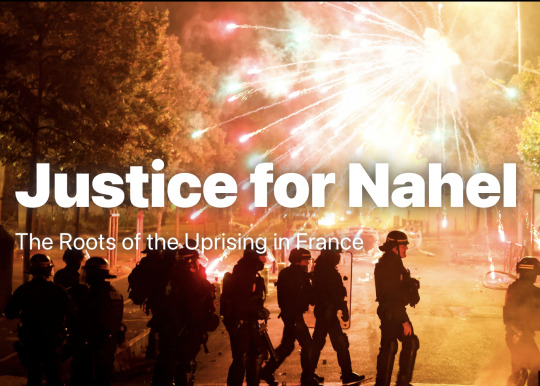

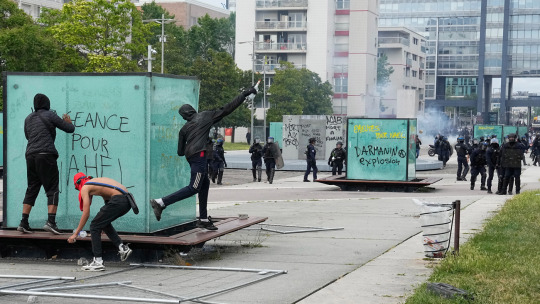
Justice for Nahel: On the Roots of the Uprising in France
http://crimethinc.com/Nahel
An uprising is underway in France in response to the murder of 17-year-old Nahel Merzouk. Participants set these events in the context of anti-racist and anti-colonial struggles in France dating back to the 1970s, and discuss its relationship to the social movements of the past two decades.
185 notes
·
View notes
Text
In the late 1990s, when I was a New York Times correspondent based in West Africa, international airline connections made passing through Paris a rite of both work and vacation. On one such visit, I received a shock that has stuck with me. As I approached a subway station not far from the Champs-Élysées, out of its stairwell came running two policemen, their guns drawn, as they pursued a young Black man whom they caught up to, badly manhandled, and then hauled away under arrest.
As someone who had grown up in Washington, D.C., and recently moved to Africa from New York City—or simply as someone who had watched U.S. local news broadcasts and grown up consuming his country’s violent small- and large-screen offerings—I had been trained to think that urban scenes such as these were a unique product of my own country.
On subsequent transits through Paris, I was disabused of yet more of my naivete when I began taking trains into the central city instead of taxis. Maybe it was a labor strike that had caused me to do this at first, but the experience so intrigued me that I began making a habit of it. Not even in New York had I felt such a gulf between the popular image of a city and this kind of lived experience of it via public transportation.
For long sections of these rides, the cars were filled with Black and brown people–– overwhelmingly young and, I surmised, overwhelmingly either the children of recent immigrants or immigrants themselves, with France’s former colonies in North and sub-Saharan Africa the most likely places of origin. Before reaching the stylish, urban dreamland exalted in countless romantic Hollywood fantasies and more than a century of novels and travel writing, one must traverse something altogether different and discordant: a huge expanse of what the French rather delicately refer to as banlieues. They needn’t have resorted to the term, though. For many of these places, the old European word “ghetto” would have fit just fine.
Passing through and eventually visiting some of them, I was reminded of other grim cityscapes I have known in other parts of the world. The comparisons are admittedly not perfect, but segregated townships built under South African apartheid came to mind, as did some of the bleaker sections of New York where I had once paid dues as a local reporter, such as the more depressed parts of the Bronx.
As with the notorious infrastructure schemes of the powerful New York master planner of the last century, Robert Moses, which deliberately isolated Black communities and cut them off from areas privileged in terms of race and class and from public amenities such as the city’s beaches, Paris’s banlieues are poorly connected to the city’s transportation system, heightening their economic and social isolation and therefore their misery. For those looking for points of optimism after France’s recent civil disturbances, projects underway or on the books are expected to dramatically increase subway connections for these long-neglected parts of the city.
There is an old saw that holds that history never repeats itself but often rhymes. And it was just such a resonance—and not the recent events in Paris themselves, per se—that has brought France’s capital powerfully to mind for me.
To briefly review those events, though: On June 27, a French teenager of Algerian descent was fatally shot by a police officer during a traffic stop in what amounted to a virtual execution. A video of the incident that was widely shared online shows a police officer shoot 17-year-old Nahel Merzouk at close range through his window as his car pulls away.
Outraged young people, who were disproportionately “of color,” then rose up in protests that lasted for six days and included numerous acts of looting, vandalism, and even violence. This, in turn, drew florid condemnations from broad segments of French society, with many people using racialized language or outright racism to denounce not just the protesters’ behavior, but also the growing presence of minority groups in France and the immigration that helps drive it.
What has intrigued me here is a powerful coincidence of timing—and, as I will explore below, perhaps a deeper connection in terms of history and significance with a major decision by the U.S. Supreme Court. And therein, a paradox arises.
France has long prided itself on its all-but-unique handling of racial diversity. Official policy comes close to pretending that such a thing does not exist and takes this for an unqualified positive. The republic is indivisible, says one often invoked phrase, and in the pursuit of its supposed universalism, France has made it illegal to collect data on the basis of a person’s race.
If it is possible to glimpse some admirable idealism in France’s notion of universalism, it has an insufficiently acknowledged dark side as well. Firstly, it requires a near complete assimilation into the dominant national identity of we might call “Frenchness,” which is overwhelmingly defined and policed by people of one race. This might even be considered one of its main, if unstated, features. In order to function, French universalism requires a charade: pretending to be colorblind.
This colorblindness may help prevent French people from noticing that their television news industry or their cinema, to take two industries, are crushingly white, well beyond the true demographic breakdown of the society. But it does nothing to alleviate the underlying reality that opportunity still correlates strongly to race in the country. The same, for that matter, is true of life in the isolated banlieues, as opposed to the tonier parts of the city. I have little doubt that the same patterns hold in other spheres of society as well, from elite educational institutions to national politics.
France’s readiest and most powerful counterexample is, of course, the United States, which has long served as an almost archetypical national “other” to justify French policies and obtain buy-in from a French public that has been socialized over generations to view the United States both with haughty disdain and as a menace to the French way of life. Any idea of taking race or color into account in forming public policy is dismissed as succumbing to a dangerously corrupting Americanism.
The recent ruling by the U.S. Supreme Court that race-conscious college admissions programs violate the U.S. Constitution’s guarantee of equal protection, however, suggests the French may have little to worry about on this score. The two countries would indeed appear to be converging in favor of the French way: pretending that color doesn’t exist and that race has no place in social policy.
The Supreme Court ruling may have barred the overt consideration of race in college admissions in the United States, but it cannot pretend away the fact that Black students are dramatically underrepresented in higher education in the country, as they have been for generations—a product of actual policy during the United States’ long era of segregation and Jim Crow.
In fact, as the University of Chicago law professor Sonja B. Starr has argued, racial gaps exist across a very wide range of categories in U.S. life, from income and employment rates to maternal mortality and life expectancy to exposure to toxic environmental pollution and incarceration.
The question is: What are wealthy societies such as the United States and France to do about such realities? Overtly taking race into consideration clearly displeases large numbers of people in rich democracies, especially among those who have benefited most from inequality. If governments are not allowed to even weigh the racial facts before them, what realistic hope is there for public policy to redress these problems?
5 notes
·
View notes
Text
2,500 fires started. 2,000 people detained. France's protests by the numbers
2 notes
·
View notes
Text
A direct Telegram from the Cour des Competes (Supreme Audit Court)

03 September 2024 As much as budgetary abysses are a concern, we have NEW investigation updates on the (already dissolved) 25,678 protestors. While the mobs have died down, the price to pay was immense. For the past 2 days, the germanderie deployed on-site to quash the French mobs have reportedly been displaying "disproportionate aggression, especially towards ethnic minorities". TRANSCRIPT EXCERPT FROM AN AFRICAN-AMERICAN BYSTANDER: "I was just watching the protests,... then the police comes along to beat me incessantly. Not even the French Whites who are rowdy! But me!... It's like the 2023 Nahel Merzouk incident." TRANSCRIPT EXCERPT FROM PARISIAN POLICE CHIEF, LAURENT NUNEZ: "The French police are sworn and bound by the Constitution to uphold secularism and equality regardless. We have exacted action only to those who appear as a threat, to either the police or the peace of France." President Macron makes no comment and awaits your response.
0 notes
Text
La colère des quartiers populaires
https://justifiable.fr/?p=1443 https://justifiable.fr/?p=1443 #colère #des #populaires #quartiers Présentation de l’éditeur La colère a fini par éclater : à l’été 2023, suite à la mort de Nahel Merzouk, la France a connu des révoltes aussi violentes qu’éphémères. Comprendre les racines du soulèvement requiert de se plonger dans le quotidien des quartiers populaires. À partir d’une enquête ethnographique de dix ans dans la ville de Roubaix, ce livre saisit la texture de sentiments d’injustice davantage orientés vers l’État que contre le capitalisme. Il suit au long court la trajectoire de militants qui tentent de briser la résignation et de susciter la participation. Ces artisans de l’égalité sont pourtant souvent disqualifiés et leurs luttes, réprimées. La démobilisation populaire apparaît alors comme une production politique, où les difficultés de la gauche à appréhender la nouvelle sociologie des classes populaires apparaissent décisives. On comprend alors pourquoi les quartiers populaires se révoltent et pourquoi ils ne le font pas plus souvent. Sommaire PREMIERE PARTIE. REPRESENTER LES QUARTIERS POPULAIRES CHAPITRE 1. TENTATIVES D’ORGANISATION AUTONOME DES DESCENDANTS D’IMMIGRES CHAPITRE 2. RECONNAISSANCE ET DISQUALIFICATION. L’IMPOSSIBLE LUTTE CONTRE L’ISLAMOPHOBIE CHAPITRE 3. LA GAUCHE ET LA QUESTION RACIALE DEUXIEME PARTIE. LA CITOYENNETE ENTRAVEE CHAPITRE 4. LES RAISONS DE LA COLERE. DISCRIMINATIONS, SENTIMENTS D’INJUSTICE ET POLITISATION ORDINAIRE CHAPITRE 5. L’ISLAM COMME SALUT CHAPITRE 6. RESIGNES. SE DETOURNER D’UN JEU POLITIQUE QUI VOUS MALTRAITE TROISIEME PARTIE. LA PRODUCTION POLITIQUE DE LA DEMOBILISATION POPULAIRE CHAPITRE 7. LUTTER PAR LA PAROLE ? POURQUOI LES COLLECTIFS ANTIRACISTES PEINENT A MOBILISER CHAPITRE 8. LUTTE URBAINE AU PILE : LES CONDITIONS SOCIALES D’UNE REMOBILISATION EPHEMERE CHAPITRE 9. LA SOCIETE CIVILE ETOUFFEE Source link JUSTIFIABLE s’enrichit avec une nouvelle catégorie dédiée à l’Histoire du droit, alimentée par le flux RSS de univ-droit.fr. Cette section propose des articles approfondis et régulièrement mis à jour sur l’évolution des systèmes juridiques, les grandes doctrines, et les événements marquants qui ont façonné le droit contemporain. Ce nouvel espace est pensé pour les professionnels, les étudiants, et les passionnés d’histoire juridique, en quête de ressources fiables et structurées pour mieux comprendre les fondements et l’évolution des normes juridiques. Plongez dès maintenant dans cette catégorie pour explorer le passé et enrichir vos connaissances juridiques.
0 notes
Link
The French police officer accused of killing 17-year-old Nahel Merzouk, triggering riots across the country, has been freed from jail amid an ongoing investigation.
0 notes
Text
French climate activists are waging war against water hoarders
“As of 30 June, 42 of France’s 96 mainland départements (administrative divisions) contain at least one area with water restrictions. 15 of these 42 are officially in crisis, meaning water usage is restricted to priority functions: health, civil security, drinking water and sanitation.
“It’s no surprise, then, that French climate groups are escalating their tactics in the fight over water. In August last year during water restrictions in Vosges in eastern France, activists drilled holes in jacuzzis at a holiday resort. Over the winter, others sabotaged artificial snow canons at Clusaz, south-eastern France, while others set up a ZAD (autonomous zone) in the area, citing the winter drought as their motivation.
“The most contentious of these groups is Les Soulèvements de La Terre, or ‘Earth Uprising’, which is currently waging 100 days of action against ‘water hoarders’ across the country. In response, the French state is cracking down on so-called eco-terrorism – and hard. Earth Uprising’s aim is to ‘take ecologism back to the land’, spokesperson Basile explains to Novara Media. ‘When we talk about climate change, it can feel like something that’s very far away,’ he says. ‘But defending agricultural land, the green spaces where we live, that’s very tangible.’
“In recent months, this rationale has led Earth Uprising to fight against ‘concretisation’, as concrete production is water intensive. In December, the group targeted concrete production firm Lafarge in Bouc-Bel-Air in southern France. 200 activists broke onto the site, attacking equipment with hammers and axes and setting light to vehicles. Notably, Basile explains, Lafarge wasn’t just targeted for its concretisation plans, but for funding Islamic State in Syria.
“Earth Uprising also targets agribusiness, blockading Monsanto sites and attacking megabasins – large, man-made reservoirs which store water for agricultural use, filled by pumping water from the water table in the winter months. In March, 30,000 people descended on a megabasin construction site in Sainte-Soline in western France, sabotaging the pumps. When the police fired grenades and teargas into the crowd, the crowd fought back. 5,000 grenades were used over the course of a few hours, and by the end of the day, hundreds of protesters and dozens of police were injured.
“‘France is the only western democracy where maintaining order involves firing on the crowd with military grade weaponry,’ Basile says. This can be seen from the state response to the gilets jaunes to the recent wave of protests following the killing by police of unarmed 17-year-old Nahel Merzouk.”
#les soulevements de la terre#earth uprising#drought#megabasins#concrete#environmental activists#climate activists#environmental activism#climate activism#activists#activism#protestors#protest#police violence#police#environment#climate#france#europe
0 notes